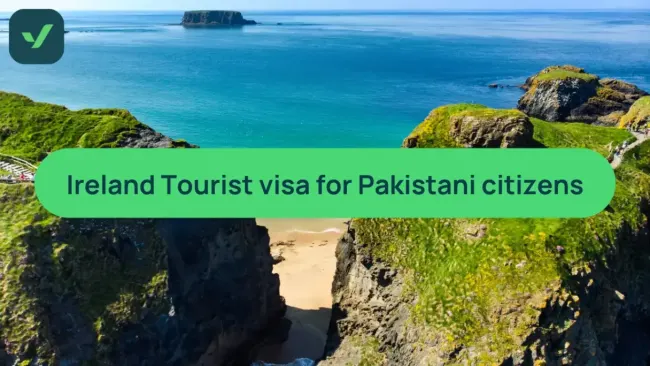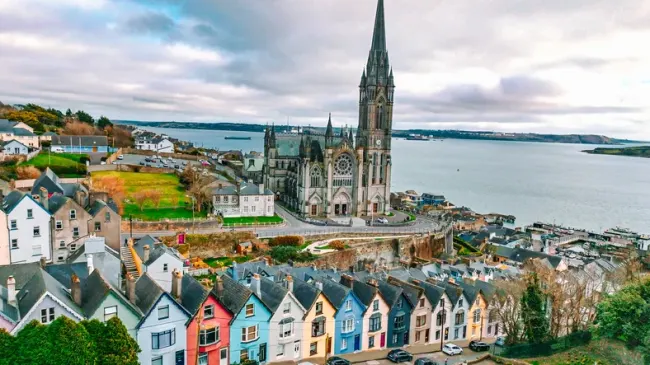
Ireland Travel Guide: All you need to know to visit Ireland in 2023
Welcome to Ireland
There's something about Ireland that attracts many different types of travelers. The country has a vibrant capital that offers culture, great tourist attractions, traditional Irish music, and medieval architecture, while the countryside is full of green landscapes, national parks, small towns, and history.
To make sure you get the most out of your trip, we’ve prepared this ultimate Ireland travel guide with tips and tricks, and all the practicalities you need to know, such as visas, before you go.
Document checklist for Ireland
- Visa copy
- Valid passport
Essential Ireland travel information
-
Currency - Euro (€). $1 is equivalent to approx. €0.98.
-
Daily budget for 1 person - Allow a daily budget of €109 ($111).
-
Languages - People in Ireland speak English, while many also speak Irish (Gaelic).
-
Top 3 cities to visit - Dublin, Galway, and Kilkenny
-
Top 3 landmarks/monuments - Cliffs of Moher, Guinness Storehouse, and Killarney Park.
-
Socket type - Type G, 230V supply voltage and 50Hz.
-
Time zone - Greenwich Mean Time (GMT) : ET +5.
Visa information for Ireland
U.S. citizens may find Ireland a convenient destination as they currently don’t need a visa to visit the country for tourism purposes. For business or medical purposes, it’s still necessary to do a visa application.
Other nationals from countries outside the European Union may still need to apply for a visa. Please contact your nearest Irish embassy or consulate to check if you are eligible. Ireland does not accept Schengen or UK visas. To guarantee a smooth arrival in Ireland, you can also choose to submit an Embassy Registration.
Typical costs and budget for Ireland
Once you have decided on your Ireland travel plans, you might wonder what to expect in terms of costs. Here’s a basic guide to what to spend on a daily basis traveling through the Emerald Isle on a decent budget.
Daily spending - You can expect to spend €109 ($111)/per person, per day on a budget vacation. This includes:
-
Meals - €32 ($34)
-
Transport - €18 ($20)
-
Hotel - €101 ($105), for two people
A trip for two people for one week will cost on average €1,532 ($1,565). If you want to save money, there are also many budget hostels and simple eateries to enjoy in any larger city.
Transport and best ways to travel around Ireland
Ireland is a small island, so you can easily travel through. For longer distances, the Irish rail system will provide fast and comfortable train travel, typically running hourly. The bus is also an efficient option to travel around Ireland since the country offers many rural and urban routes.
To explore the cities, buses, trams, and trains are available in most places, but walking in any small town is of course the best way to discover the cobbled streets and medieval architecture. Renting a car is a great option to drive around the countryside for a few days and see the small towns, gorgeous scenic routes, and amazing views on a road trip.
Safety in Ireland
Ireland is very safe for tourists, just like in other European countries. According to the Peace Index List of 2022, it’s ranked 10th world’s safest country. You’ll find low criminal rates and don’t need to worry if you keep the general travel precautions in mind.
In crowded public spaces, it’s always recommended to be aware to avoid pickpockets. It’s always a good idea to get travel insurance for your trip to Ireland.
Weather in Ireland
At different times of the year you can often find bright sunshine in Ireland, but always keep an umbrella on you. It’s common to encounter rain showers at any time of day, any time of the year.
Spring, summer, and autumn are all great seasons to visit Ireland, as each season offers a unique atmosphere. Summer stands out for its favorable conditions and warmer temperatures. It’s also the peak season for tourism, and you may experience higher accommodation. Ireland offers its own charm in winter when you can enjoy snowfall in the mountains and countryside.
-
Spring (March - May): between 8ºC (46,4ºF) and 12°C (53,6ºF).
-
Summer (June - August): between 16ºC (60,8ºF) and 22°C (71,6ºF).
-
Fall (September - November): between 14ºC (57,2ºF) and 18°C (64,4ºF).
-
Winter (December - February): between 4ºC (39,2ºF) and 10°C (50ºF).
Popular cities and towns in Ireland
A trip to Ireland can be an unforgettable experience. The entire country offers amazing attractions, from medieval towns to beautiful villages on the coast of the Atlantic Ocean. Here are some of the best attractions.
-
Dublin - The capital city of the Emerald Isle is diverse and full of life. It offers history, fun pubs, and a lot of museums. If you have to choose just one city to visit in Ireland, it should be Dublin.
-
Galway - A lively city for those who would also like to enjoy the outdoors. Check out the Latin Quarter and get to know its history. For natural attractions, tour the Wild Atlantic Way, a scenic route that runs through the city.
-
Limerick - This Irish city offers a lot of cultural attractions, such as art galleries and museums. Here, you’ll also find historic buildings to learn more about Irish architecture, such as King John's Castle.
-
Kilkenny - This medieval town is rich in Irish history. Sights like Kilkenny Castle, St. Canice's Cathedral, and the Medieval Mile Museum are definitely worth the journey.
-
Cork - The second-largest city in Ireland is also one of the most welcoming. Enjoy the local shops, museums, art galleries and visit the Blarney Castle to kiss the Blarney stone, a ritual that people believe gives the gift of the gab! Most people visit Cork on day trips.
Must see and do in Ireland
Here’s your guide to the very best things to see and do in Ireland:
-
1. Drink the iconic Ireland beer in the Guinness Museum. Experience the history of this iconic brand and the soul of the traditional Irish drink in a beautiful building.
-
2. Visit the Glenveagh National Park. This is Ireland’s second-largest park, and it is home to Glenveagh Castle, a late 19th-century castellated mansion.
-
3. If you love nature, go to the Killarney National Park. Located in the countryside on Ireland's Southern Coast, it was the first park of its kind in the country. It’s known for the diversity and extensiveness of plant and animal species that call this area home.
-
4. Sip on traditional Irish whiskey in Temple Bar. This is not just a bar, but a whole street of pubs, while its namesake pub is home to a huge whiskey collection and a great place to appreciate the traditional music.
-
5. Visit the National Gallery of Ireland, in Dublin. It keeps a fine art collection, with paintings by Irish, Italian, French, Spanish, Dutch, and German masters.
-
6. Go to the Cliffs of Moher in Galway Bay. Located on Ireland's west coast, the cliffs offer a breathtaking landscape. They were the setting for movies like Leap Year (2010) and Harry Potter & the Half-Blood Prince (2009).
Typical Irish food to try
The food from Ireland is simple and family-style, and offers a warm welcome to the rainy climate! You’ll see a lot of great food with potatoes and dishes that follow the season, like lamb in spring, fish in the summer months, and stews and soups in winter.
-
Soda bread - You’ll probably find this Irish bread with your breakfast. Some like it sweet with a spoonful of honey, sugar, or dried fruits, while others prefer a healthy version with sprinkled-in seeds, bran, and oats. However, the basic ingredients are always the same: bicarbonate of soda and buttermilk form the raising agent, mixed in with the flour.
-
Irish stew - This one-pot dish is traditionally made with mutton, onions, and potatoes. To avoid the stew getting too wet, it’s usual to add pearl barley, roux, or sliced potatoes.
-
Colcannon - Another Irish specialty with potatoes, colcannon is a classic, comforting mash of potatoes, cabbage (or kale), and butter (or cream), flavored with spring onions.
-
Boiled bacon and cabbage - A family recipe, for this dish has salted pork soaked overnight before being boiled, with cabbage added during the last 10 minutes.
-
Black and white pudding - Black pudding is a mix of pork meat, fat and blood mixed with barley, suet, and oatmeal in an intensely flavored sausage. While white pudding is pretty much the same, just without the blood. Usually these are served together, a slice of each, with your Irish breakfast.
Celebrating St. Patrick’s Day
St. Patrick’s Day is a very important holiday in Ireland. During the festival, the Irish take to the streets of cities like Dublin and Cork in honor of St Patrick, come rain or shine.
According to history, the saint was captured from either Wales or Scotland and sent to Slemish Mountain in County Antrim as a slave. He tended sheep in the mountainside until the day he had a vision telling him to return to Ireland and spread the message of Christianity.
St. Paddy’s is celebrated on the 17th of March and has been for the last 1,000 years. However, the parades that color newspapers and magazines green the day after are more recent. This tradition started in New York City, which held the first official St. Paddy’s Day parade in 1762, created by Irish-born settlers in the United States.
Vaccine information for Ireland
There are some vaccines are recommended for your trip to Ireland, as well as keeping up-to-date with your COVID-19 vaccinations. For further information on health before your travel to the country, check the advice from the CDC for Ireland.
Fun facts about Ireland
Check out these fun facts about Ireland as you prepare for your trip to the Emerald Isle:
-
1. Guinness is the most famous drink from Ireland, but the black beer is more consumed by British and Nigerians than by Irish citizens.
-
2. If you’re afraid of snakes Ireland is a great place to visit! There have never been wild snakes on the island of Ireland since the snakes inhabiting Britain were never able to make it across the water.
-
3. There are more Irish living outside of Ireland than in the country. The population of the country currently sits at around 4.8 million people, while it has been reported that almost 80 million people around the world have Irish passports.
-
4. Ireland was the Titanic’s last port of call. While the Titanic officially left for America from Southampton in England, its last port of call was in Cobh, County Cork.
-
5. Ireland was the 1st country in the world to legalize gay marriage by public referendum. A majority of 68% of the population voted in favor of the new legislation in May 2015.

 United Kingdom
United Kingdom
 United States
United States
 Japan
Japan
 Canada
Canada
 Mexico
Mexico
 Vietnam
Vietnam
 India
India
 Brazil
Brazil
 Australia
Australia
 New Zealand
New Zealand
 Indonesia
Indonesia
 Thailand
Thailand


